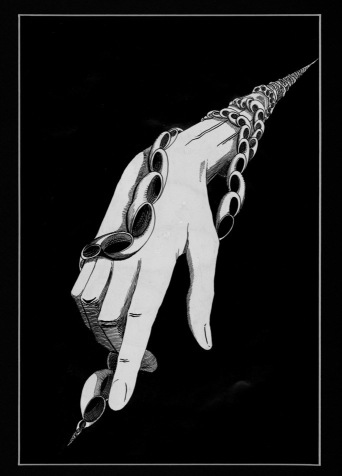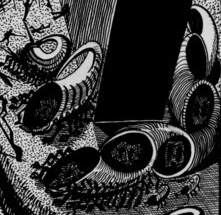A Mysterious Bracelet
 The Fomenko drawing on the left is from the original Russian edition of Homotopic Topology by Fuks, Fomenko and Gutenmacher. Dmitry Fuchs signed this book for me after my success in the USSR Math Olympiad when I was in the 9th grade. For many years I didn’t know what the picture meant and was mystified by it. Now the book has been republished with explanations and is available in English at a non-affordable price. You can find this picture and many other Fomenko drawings in his book called Mathematical Impressions, which is affordable, although the comments accompanying the illustrations are confusing. So I have my own explanation for the meaning of this illustration.
The Fomenko drawing on the left is from the original Russian edition of Homotopic Topology by Fuks, Fomenko and Gutenmacher. Dmitry Fuchs signed this book for me after my success in the USSR Math Olympiad when I was in the 9th grade. For many years I didn’t know what the picture meant and was mystified by it. Now the book has been republished with explanations and is available in English at a non-affordable price. You can find this picture and many other Fomenko drawings in his book called Mathematical Impressions, which is affordable, although the comments accompanying the illustrations are confusing. So I have my own explanation for the meaning of this illustration.
 The bracelet is made out of shells. Each shell is a hollow cone whose vertex is glued to a point on the rim of the cone’s opening, thus giving each hollow cone its own handle. In a part of another drawing (at left), Fomenko shows how the bracelet is built by an army of tiny slaves. First they build the shells and then they connect them together.
The bracelet is made out of shells. Each shell is a hollow cone whose vertex is glued to a point on the rim of the cone’s opening, thus giving each hollow cone its own handle. In a part of another drawing (at left), Fomenko shows how the bracelet is built by an army of tiny slaves. First they build the shells and then they connect them together.
How do they connect the shells to each other? The rim of the next shell is glued to the handle of the previous shell. Let me remind you that a straight line connecting a point on the rim to the vertex of a cone is called a generatrix. Imagine a generatrix that connects a vertex of a cone to the point on the rim to which this vertex is glued. This generatrix becomes a circle in a shell, which I call the handle circle. So the rim of the next shell is glued to the handle circle of the previous shell.
Now consider the fundamental group of a shell. The rim can be contracted to the handle circle. Moreover, the cone itself can be contracted to the handle circle. If we glue several shells together, the result is contractible to the handle circle of the last shell.
Now let’s go back to the bracelet. The shells become smaller in both directions and end in two points. The front end point is more interesting topologically than the one in back. Every point other than the front end has a contractible neighborhood, while the front end point does not. Or in scientific terms: The bracelet gives an example of a space with a point at which the space is “1-lc” but with no open neighborhoods on which every (Cech) 1-cycle bounds.
Share:
El arte de Anatoli Fomenko « :: ZTFNews.org:
[…] Del libro “Homotopic Topology” de A. T. Fomenko y D. B. Fuks. Representa un espacio de Hausdorff y localmente compacto que no es (homológicamente) localmente conexo (en el sentido de Cech) en dimensión 1. Ver https://blog.tanyakhovanova.com/?p=400 […]
10 June 2012, 2:29 pm